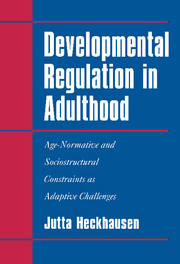 Developmental Regulation in Adulthood
Developmental Regulation in Adulthood Published online by Cambridge University Press: 05 September 2009
In Chapter 2 the biological, sociostructural, and age-normative constraints to the individual's developmental regulation were discussed. This chapter focuses on the role played by the individual in regulating life-span development in the context of these constraints and presents a theoretical model. As argued in Chapter 2, constraints to developmental options are not merely restrictions, but serve as a scaffold to keep the developmental options manageable and help the individual to focus on crucial developmental challenges at any given point in the life course.
Selection, Compensation, and Optimization
As we have seen, the fundamental requirements of developmental regulation across the life span are the management of selectivity and the compensation of failure (Chapter 1). P. Baltes and M. Baltes (M. Baltes 1987; P. Baltes 1987, 1991, 1993; P. Baltes & M. Baltes 1990; P. Baltes, Dittmann-Kohli, & Dixon 1984; Marsiske, Lang, P. Baltes, & M. Baltes 1995) have proposed a metamodel of “selective optimization with compensation” (SOC), which is most relevant here because it involves the aspects of selection and compensation. In the P. Baltes and M. Baltes model, life-span development is conceptualized as a process of continuous selection in the investment of motivational and cognitive resources. This selection process helps the individual to deal with agingrelated decline in the ratio between developmental gains and losses and decreasing reserve capacity.
To save this book to your Kindle, first ensure no-reply@cambridge.org is added to your Approved Personal Document E-mail List under your Personal Document Settings on the Manage Your Content and Devices page of your Amazon account. Then enter the ‘name’ part of your Kindle email address below. Find out more about saving to your Kindle.
Note you can select to save to either the @free.kindle.com or @kindle.com variations. ‘@free.kindle.com’ emails are free but can only be saved to your device when it is connected to wi-fi. ‘@kindle.com’ emails can be delivered even when you are not connected to wi-fi, but note that service fees apply.
Find out more about the Kindle Personal Document Service.
To save content items to your account, please confirm that you agree to abide by our usage policies. If this is the first time you use this feature, you will be asked to authorise Cambridge Core to connect with your account. Find out more about saving content to Dropbox.
To save content items to your account, please confirm that you agree to abide by our usage policies. If this is the first time you use this feature, you will be asked to authorise Cambridge Core to connect with your account. Find out more about saving content to Google Drive.